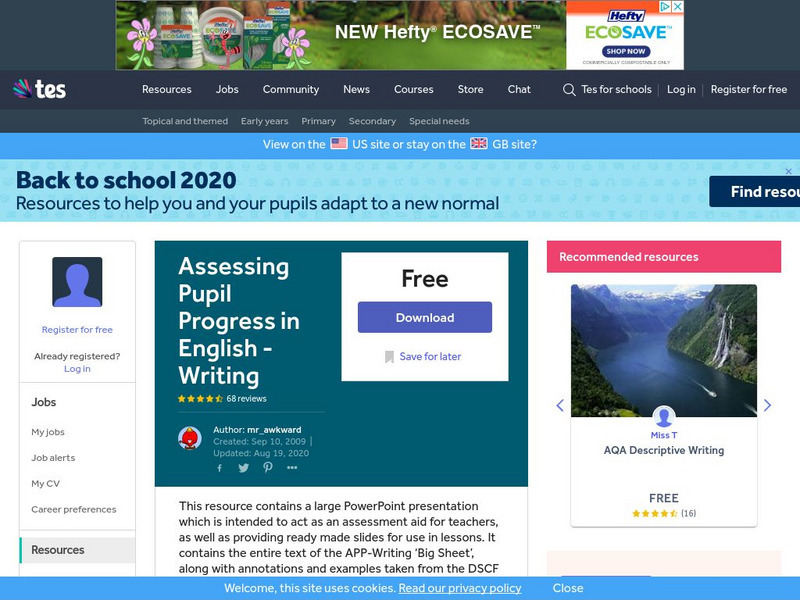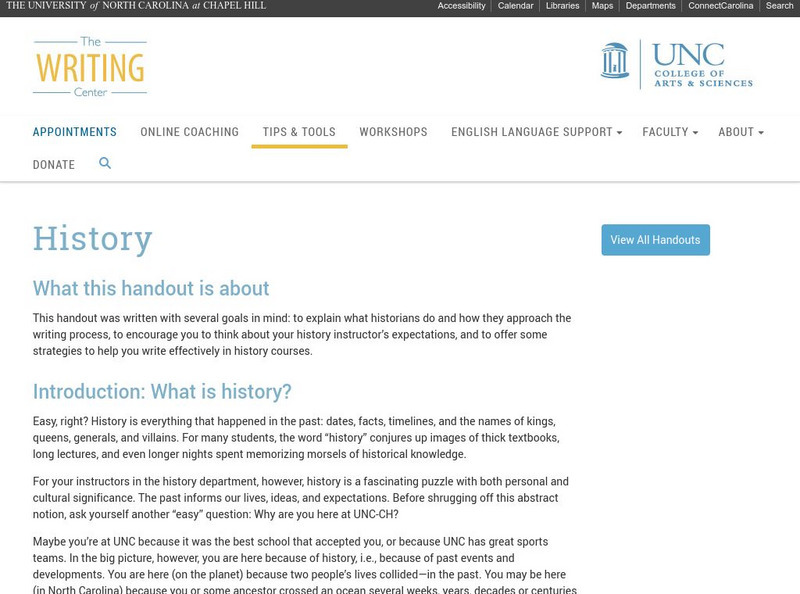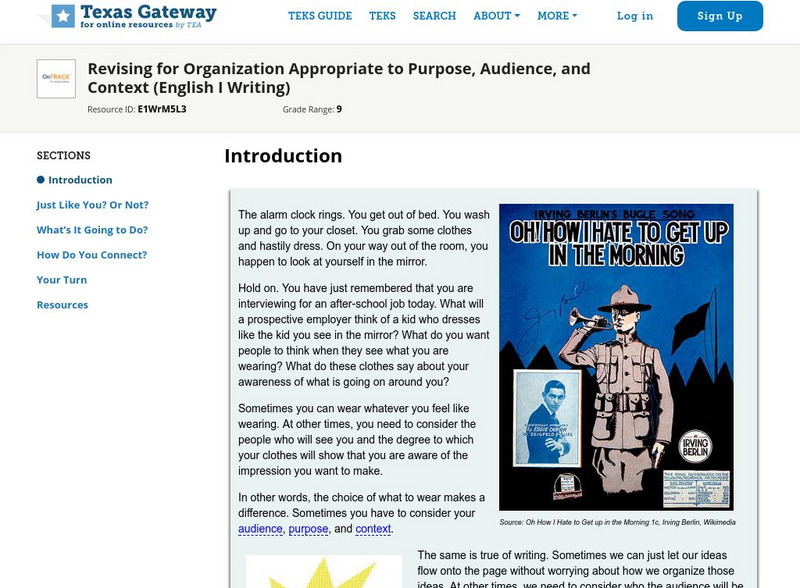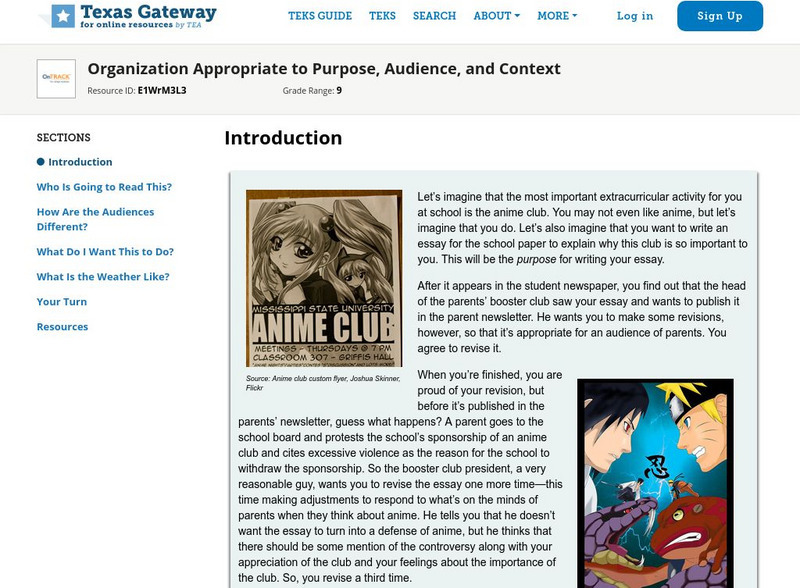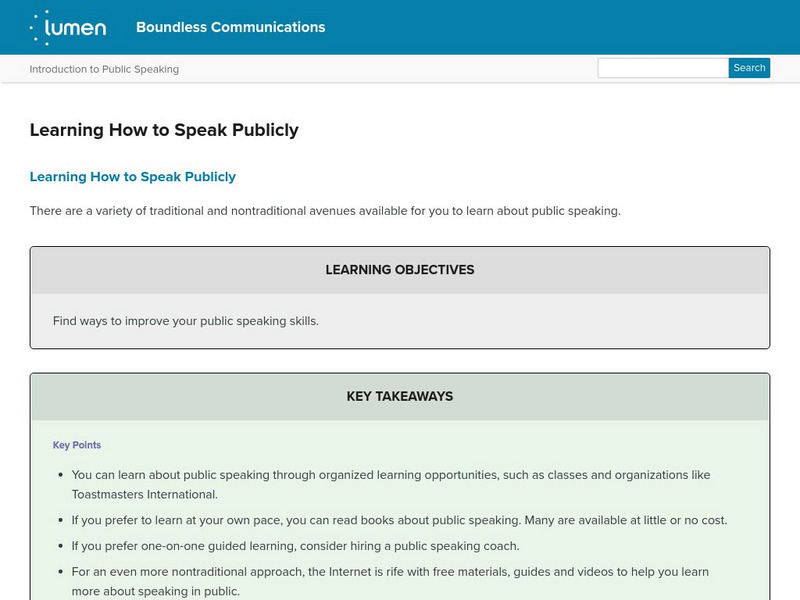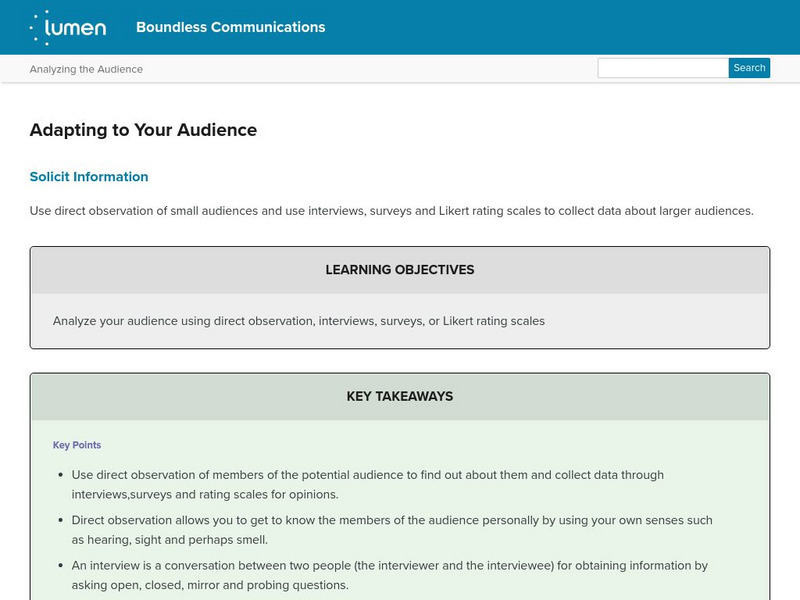Grammarly
Grammarly Handbook: Organization and Development
A list of five focuses in the areas of organization and development. Links to each focus area are provided.
Other
Ncte: Organizing Your Writing
This PDF article explains five different patterns of organization to help students select an organization that matches the purpose of their writing so that the audience can more easily follow along. The patterns are sequential, spatial,...
Other
Univ. Of Washington: How to Make an Outline [Pdf]
Information on how to make an outline. Provides a sample.
TES Global
Tes: Assessing Pupil Progress in English: Writing
[Free Registration/Login Required] This PowerPoint provides exemplar pieces to guide students to understand how to revise a standardized, on-demand writing assessment piece.
Scholastic
Scholastic: Writing Persuasive Letters
A lesson plan that prompts students to write persuasive letters and lobby for issues they feel strongly about.
University of North Carolina
University of North Carolina: Writing Center: Handouts: Writing About History
Students are provided with an eight-step process for completing academic writing on historic topics. Steps include understanding the topic, making an argument, organizing information and supporting details, and other important writing...
Sophia Learning
Sophia: Determining Your Audience
On this website you will find information, two presentations, and a practice worksheet explaining how to decide the audience of a written piece and how to appeal to an intended or general audience in an original text....
Sophia Learning
Sophia: Paper Writing: Outlines
Show students how essential an outline is to writing a paper. This source provides explanations for writing an outline and information about how to create both formal and informal outlines.
Colorado State University
Writing@csu Guide: Understanding Writing Situations
In this guide, you can learn more about the situations in which writers and readers find themselves and the physical, social, cultural, and historical contexts that shape them. Click on each of the links on the right to learn about the...
University of Missouri
University of Missouri: Clear Writing: Ten Principles of Clear Statement
This page features a list of ten principles that lead to writing clearly and concisely, such as avoiding unnecessary words, writing like you talk, writing to express and not to impress, and the like. It also discusses "fog indexes" to...
Varsity Tutors
Varsity Tutors: Web English Teacher: Expository Writing
This Web English Teacher provides great links and resources for assistance, activities, and information about expository writing.
Capital Community College Foundation
Guide to Grammar and Writing: Sense of Purpose
Not only does this site from Capital College Community Foundation give you a fine explanation of writing purpose and how to identify yours, it also provides good examples of how to develop that purpose in a piece of writing. W.9-10.4...
Sophia Learning
Sophia: Writing for an Audience
A seven-slide presentation discussing the importance of writing to an audience in order to establish tone, strengthen word choice, and determine what supporting details to include.
Wisc-Online
Wisc Online: Introducing Your Speech
Follow these do's and don'ts of writing an effective introduction to a speech that will grab your audience's attention and state your central idea. Use the arrows to move through the information.
Texas Education Agency
Texas Gateway: Revising for Organization for Purpose, Audience, and Context
[Accessible by TX Educators. Free Registration/Login Required] Learn strategies for evaluating and revising the organization of an essay appropriate to purpose, audience, and context. CCSS.ELA-Literacy.WHST.6-8.5 Develop and strengthen...
Texas Education Agency
Texas Gateway: Organization Appropriate to Purpose, Audience, and Context
[Accessible by TX Educators. Free Registration/Login Required] Write an essay that is organized appropriate to audience, purpose, and context.
Texas Education Agency
Texas Gateway: Effective Introduction and Conclusion Sentence Structure Variety
Write effective introductions and conclusions with a controlling idea or thesis, using a variety of sentence patterns.
Lumen Learning
Lumen: Boundless Communications: Learning How to Speak Publicly
This site provides a variety of ways for people learn how to speak publicly and the best practices in preparing and presenting speeches. SL.9-10.4 Presentation
Lumen Learning
Lumen: Boundless Communications: Adapting to Your Audience
This lesson plan focuses on adapting your speech to your audience including analyzing your audience using direct observation, interviews, surveys, or Likert rating scales and then apply knowledge about the audience to adjust the message...
Lumen Learning
Lumen: Boundless Communications: Principles of Organization
This lesson focuses on the importance of organizing your speech including critically thinking about the contents of the speech, the components of the speech, the patterns of organization to fit the different types of speeches, and...
Lumen Learning
Lumen: Boundless Communications: Main Points
This lesson focuses on choosing the main points of your speech based on your audience and purpose. It also discusses ordering and highlighting your main points using visual and textual cues and using a variety of examples.
Lumen Learning
Lumen: Boundless Communications: Introduction
This lesson focuses on the introduction to your speech. It includes the role of the introduction, strategies for the opening, getting attention and interest, establishing credibility, self-presentation, and introducing the topic, thesis,...
Lumen Learning
Lumen: Boundless Communications: Conclusion
This lesson focuses on writing the conclusion of your speech including the role of the conclusion, summarizing ideas, signaling the end, and managing Q&A.
Lumen Learning
Lumen: Boundless Communications: Outlining
This lesson focuses on outlining your speech including the reasons for outlining, the kinds of outlines including their purpose what goes into each.



